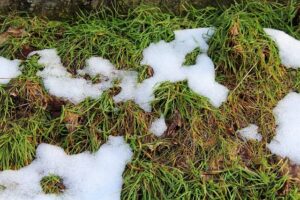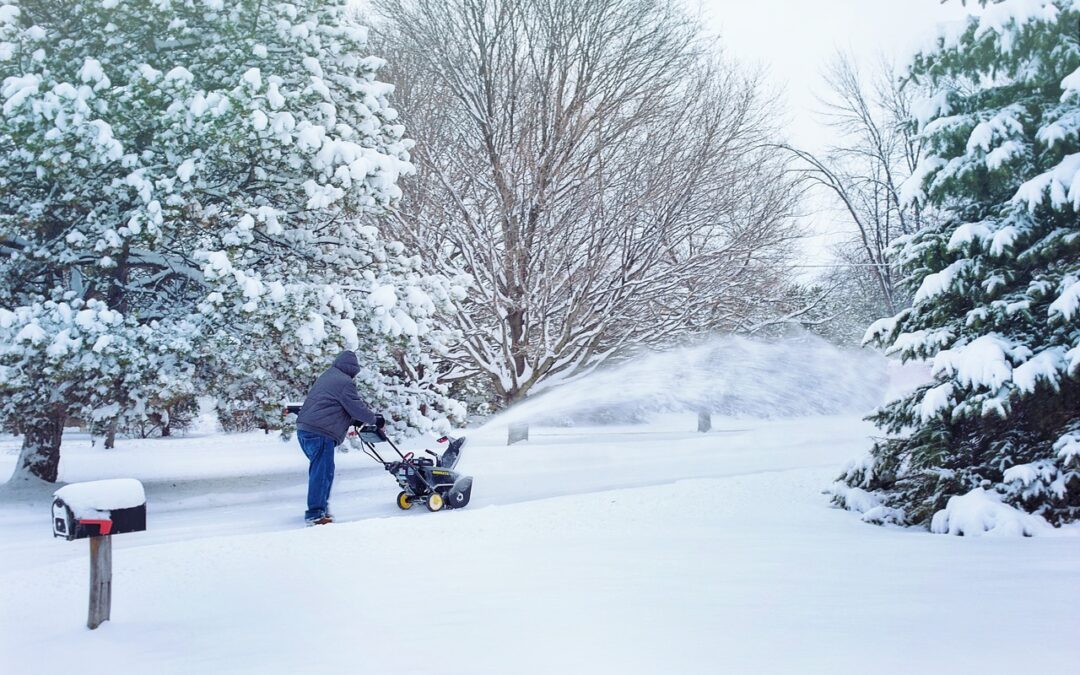As we find ourselves in the middle of another Maine winter, the ground is snow covered (for the most part) and turfgrass is without a doubt dormant underneath it all. While it may be easy to forget about your lawn over the winter, there are many things that happen before, during, and after winter that can affect how your lawn performs in the season to come.
YOUR LAWN BEFORE THE SNOW FALLS
During the late fall, we begin to get frosts once night temperatures drop below 36 degrees or so. The leaf blades of the grass plant will form a frozen, crystallized layer. At these temperatures, it is more superficial than not, and the ground itself will not be frozen. Once temperatures creep down closer to 32 and below, however, a hard frost will set in. A thicker frozen layer forms on the leaf blades and the top layer of soil will become temporarily frozen. During periods of a hard frost/freeze, damage can occur to your lawn if some precautions are not taken. Because of the thicker, icy layer on the leaf blades, they can quite literally cut into plant cells if trafficked, which will kill the leaves. In the late season, these will not be able to regrow and leave a visible reminder of your frosty trails until growth resumes in the spring. The good news with this type of injury is that as long as the crowns (growing point) of the plant remain protected just above the soil level, the leaves will regenerate the following season and grow as normal.
YOUR LAWN DURING WINTER
As we move into the middle of winter, considerations should still be taken when performing any type of activity over or across your lawn, but for different reasons. In most of our service area, lawns remain mostly snow covered which provides a blanket of protection to the turfgrass plants. The snow acts as a cushion should the need arise to walk or drive across those areas, and also as insulation to shield the plants from our harsh winter temperatures. Some issues that are quite common when it comes to winter turfgrass injury involve lawn areas that have snow removed from them, resulting in bare turfgrass or with only a thin, compacted icy layer covering them. This usually results in a direct low-temperature kill of the uninsulated turfgrass plants. If the only cover that remains is ice, the results can sometimes be worse. This layer does not breathe outwardly, in turn creating an anoxic (zero oxygen) environment which also results in the death of turfgrass.
YOUR LAWN NEARING SPRING
 There is another type of potential injury that can affect your lawn as it attempts to come out of winter dormancy in the early spring, but it doesn’t have much to do with the leaves of the plant, how we traverse over lawn areas, or if we remove snow off of them. It involves the products that may be applied to our driveways and sidewalks to melt ice, that inevitably spill over onto the edges of the lawn. Rock salt and calcium chloride, among other similar materials, do a great job of keeping hard surfaces safe for walking and driving but they do so by pulling moisture out of surfaces they land on. When this happens on soil surfaces, it can cause desiccation (drying out) of both the soil itself and certain plant parts via the foliage. In addition, salts that build up in the soil, whether they are deposited there directly or trickle down via runoff from nearby meltwater, can replace other valuable nutrients and minerals that are needed by turfgrass to survive. They can also simply build up to an excess in the soil and cause lawn areas to die back or “burn” to the point they are not viable.
There is another type of potential injury that can affect your lawn as it attempts to come out of winter dormancy in the early spring, but it doesn’t have much to do with the leaves of the plant, how we traverse over lawn areas, or if we remove snow off of them. It involves the products that may be applied to our driveways and sidewalks to melt ice, that inevitably spill over onto the edges of the lawn. Rock salt and calcium chloride, among other similar materials, do a great job of keeping hard surfaces safe for walking and driving but they do so by pulling moisture out of surfaces they land on. When this happens on soil surfaces, it can cause desiccation (drying out) of both the soil itself and certain plant parts via the foliage. In addition, salts that build up in the soil, whether they are deposited there directly or trickle down via runoff from nearby meltwater, can replace other valuable nutrients and minerals that are needed by turfgrass to survive. They can also simply build up to an excess in the soil and cause lawn areas to die back or “burn” to the point they are not viable.
YOUR LAWN CARE PROFESSIONALS
While it may be necessary for safety to use ice melt products in close proximity to turf areas, careful application and avoiding excess will go a long way in helping your lawn come out of winter dormancy thriving.
Call us today at (207) 544-9420 to for all your lawn care questions and to ensure a healthy, spring green up this year! For additional reading, check out our other blog posts.

